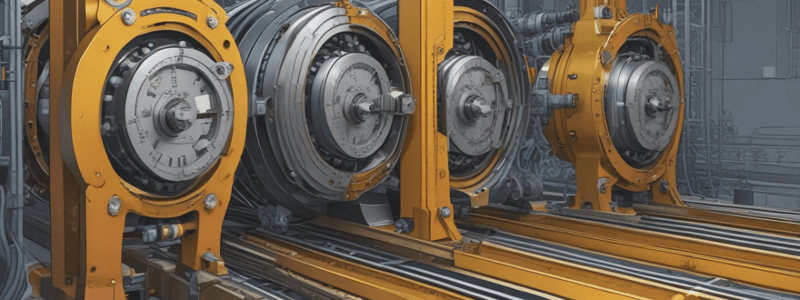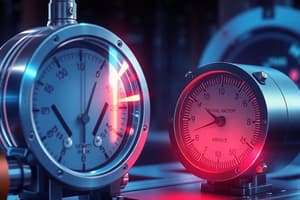Podcast
Questions and Answers
What is the primary material used in making metallic foil strain gauges?
What is the primary material used in making metallic foil strain gauges?
- Copper
- Constantan (correct)
- Steel
- Aluminum
Which type of strain gauge is immune to electromagnetic interference?
Which type of strain gauge is immune to electromagnetic interference?
- Piezoresistive Strain Gauges
- Optical Fiber Strain Gauges (correct)
- Metallic Foil Strain Gauges
- Semiconductor Strain Gauges
What is the primary application of piezoresistive strain gauges?
What is the primary application of piezoresistive strain gauges?
- Structural health monitoring
- Pressure sensors (correct)
- Experimental stress analysis
- Material development
What is the main advantage of semiconductor strain gauges?
What is the main advantage of semiconductor strain gauges?
What type of strain gauge circuit uses a single active strain gauge and three fixed resistors?
What type of strain gauge circuit uses a single active strain gauge and three fixed resistors?
What is the main application of strain gauges in mechanical engineering?
What is the main application of strain gauges in mechanical engineering?
What type of strain gauge is bonded to the surface of the test specimen with an adhesive?
What type of strain gauge is bonded to the surface of the test specimen with an adhesive?
What is the primary method of measuring strain in optical fiber strain gauges?
What is the primary method of measuring strain in optical fiber strain gauges?
Which type of strain gauge is more temperature-sensitive?
Which type of strain gauge is more temperature-sensitive?
What is the main advantage of using strain gauges on rotating shafts?
What is the main advantage of using strain gauges on rotating shafts?
What is the main advantage of using a Full-Bridge Circuit in strain gauge measurement?
What is the main advantage of using a Full-Bridge Circuit in strain gauge measurement?
What is the purpose of applying known loads in the calibration process of strain gauges?
What is the purpose of applying known loads in the calibration process of strain gauges?
What is the primary method of temperature compensation in strain gauge measurement?
What is the primary method of temperature compensation in strain gauge measurement?
What is the main consideration when using strain gauges on rotating shafts?
What is the main consideration when using strain gauges on rotating shafts?
What is the primary selection criterion for a strain gauge?
What is the primary selection criterion for a strain gauge?
What is the purpose of surface preparation in the installation of strain gauges?
What is the purpose of surface preparation in the installation of strain gauges?
What type of gauge is used to measure pressure in mechanical engineering applications?
What type of gauge is used to measure pressure in mechanical engineering applications?
What is the principle of operation of a strain gauge pressure cell?
What is the principle of operation of a strain gauge pressure cell?
What is the purpose of bonding in the installation of strain gauges?
What is the purpose of bonding in the installation of strain gauges?
What is the primary advantage of using Half-Bridge Circuit in strain gauge measurement?
What is the primary advantage of using Half-Bridge Circuit in strain gauge measurement?
What is the purpose of a strain gauge in a pressure measurement device?
What is the purpose of a strain gauge in a pressure measurement device?
What is the principle of operation of a Wheatstone bridge circuit in a pressure measurement device?
What is the principle of operation of a Wheatstone bridge circuit in a pressure measurement device?
What is the application of a Bridgeman gauge?
What is the application of a Bridgeman gauge?
What is the principle of operation of a McLeod gauge?
What is the principle of operation of a McLeod gauge?
What is the principle of operation of a Knudsen gauge?
What is the principle of operation of a Knudsen gauge?
What is the principle of operation of an Ionization gauge?
What is the principle of operation of an Ionization gauge?
What is the principle of operation of a Pirani gauge?
What is the principle of operation of a Pirani gauge?
What is the application of a Thermal Conductivity gauge?
What is the application of a Thermal Conductivity gauge?
What is the purpose of a diaphragm in a pressure measurement device?
What is the purpose of a diaphragm in a pressure measurement device?
What is the factor that determines the selection of a pressure measurement method?
What is the factor that determines the selection of a pressure measurement method?
Study Notes
Strain Measurement
- Strain gauges are essential tools in mechanical engineering for measuring strain on various structures.
- Types of strain gauges:
- Metallic Foil Strain Gauges: consist of a grid of thin metallic foil bonded to an insulating backing material.
- Semiconductor Strain Gauges: made from silicon or germanium, with higher sensitivity but more temperature-sensitive.
- Bonded and Unbonded Strain Gauges: bonded gauges are fixed to the surface of the test specimen, while unbonded gauges are mounted on a frame.
- Optical Fiber Strain Gauges: use changes in light transmission to measure strain, immune to electromagnetic interference.
- Piezoresistive Strain Gauges: primarily used in pressure sensors, utilizing the change in electrical resistance with applied strain.
Strain Gauge Circuits
- Quarter-Bridge Circuit: uses a single active strain gauge and three fixed resistors in a Wheatstone bridge configuration, simplest and least expensive.
- Half-Bridge Circuit: uses two strain gauges in the Wheatstone bridge, can measure bending strains and temperature compensation to some extent.
- Full-Bridge Circuit: uses four strain gauges in the Wheatstone bridge, provides maximum sensitivity and temperature compensation, can measure axial and bending strains accurately.
Calibration
- Calibration is essential to ensure accurate strain measurements.
- Process involves applying known loads, generating a calibration curve, and deriving a calibration factor.
Temperature Compensation
- Temperature changes can affect strain gauge readings due to thermal expansion of the specimen and the gauge itself.
- Methods for temperature compensation include:
- Using temperature-compensated strain gauges.
- Dummy gauge method.
- Quarter-Bridge temperature compensation.
Use of Strain Gauges on Rotating Shafts
- Strain gauges can be used to measure torque and stress on rotating shafts.
- Key considerations include:
- Wireless data transmission.
- Slip rings.
- Careful installation.
Selection and Installation of Strain Gauges
- Selection criteria:
- Strain range.
- Gauge factor.
- Environmental conditions.
- Material compatibility.
- Installation process:
- Surface preparation.
- Bonding.
- Wiring.
- Protection.
Pressure Measurements
- Basic methods of pressure measurement:
- Strain gauge pressure cells.
- High pressure measurement using the Bridgeman type gauge.
- Low-pressure measurement techniques:
- McLeod gauge.
- Knudsen gauge.
- Ionization gauge.
- Thermal conductivity gauges.
Strain Gauge Pressure Cell
- Principle: measures pressure using the deformation of a diaphragm or other elastic element under pressure.
- Components:
- Diaphragm.
- Strain gauges.
- Wheatstone bridge circuit.
- Operation:
- Diaphragm deforms under pressure, causing strain in the strain gauges.
- Resistance change in the strain gauges is measured using a Wheatstone bridge circuit.
High Pressure Measurement - Bridgeman Type Gauge
- Principle: measures high pressures by using the change in electrical resistance of a wire or material under pressure.
- Components:
- Pressure vessel.
- Electrical circuit.
- Operation:
- Material's electrical resistance changes under pressure.
- Resistance change is measured and correlated with the pressure.
Low Pressure Measurement
-
McLeod Gauge:
- Principle: measures low pressures by compressing a known volume of gas and measuring the resulting increase in pressure.
- Components:
- Bulb and capillary tube.
- Manometer.
-
Operation:
- Gas is trapped in a bulb and compressed into a capillary tube.
- Increase in pressure is measured with a manometer.
-
Knudsen Gauge:
- Principle: measures pressure based on the thermal transpiration effect.
- Components:
- Porous plug.
- Thermocouples.
-
Operation:
- Gas flows through the porous plug from the hot side to the cold side.
- Pressure difference created by this flow is measured and related to the absolute pressure.
-
Ionization Gauge:
- Principle: measures very low pressures by ionizing the gas and measuring the resulting ion current.
- Components:
- Ionization chamber.
- Electron source.
- Collector electrode.
-
Operation:
- Electrons from a hot filament or cold cathode ionize the gas molecules.
- Ions are collected, and the ion current is measured.
-
Thermal Conductivity Gauges:
- Principle: measures pressure based on the thermal conductivity of the gas, which varies with pressure.
- Types:
- Pirani gauge.
- Thermocouple gauge.
-
Operation:
- Pirani gauge: heat loss from a heated wire to the gas depends on the gas pressure.
- Thermocouple gauge: heat loss from a heated element to the gas depends on the gas pressure.
Summary
- The selection of a pressure measurement method depends on the range and accuracy required, the environment, and the specific application.
Studying That Suits You
Use AI to generate personalized quizzes and flashcards to suit your learning preferences.
Description
Quiz on strain measurement covering types of strain gauges, calibration, temperature compensation, and pressure measurements in mechanical engineering.




